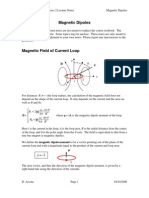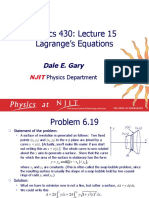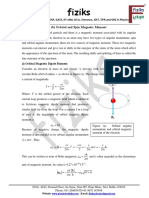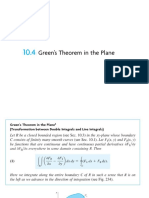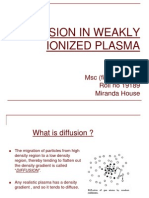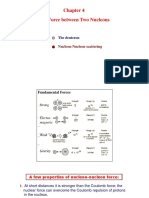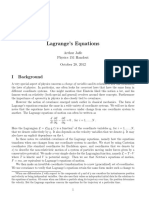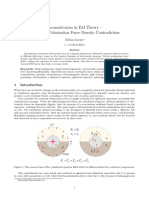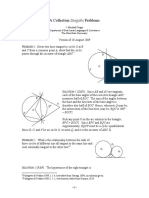Conservative Forces and Scalar Potentials: Needs "Vectoranalysis'" Curl X 2, 2 Y Z, Y 2, Cartesian X, Y, Z
Conservative Forces and Scalar Potentials: Needs "Vectoranalysis'" Curl X 2, 2 Y Z, Y 2, Cartesian X, Y, Z
Uploaded by
Abha SrivastavaCopyright:
Available Formats
Conservative Forces and Scalar Potentials: Needs "Vectoranalysis'" Curl X 2, 2 Y Z, Y 2, Cartesian X, Y, Z
Conservative Forces and Scalar Potentials: Needs "Vectoranalysis'" Curl X 2, 2 Y Z, Y 2, Cartesian X, Y, Z
Uploaded by
Abha SrivastavaOriginal Description:
Original Title
Copyright
Available Formats
Share this document
Did you find this document useful?
Is this content inappropriate?
Copyright:
Available Formats
Conservative Forces and Scalar Potentials: Needs "Vectoranalysis'" Curl X 2, 2 Y Z, Y 2, Cartesian X, Y, Z
Conservative Forces and Scalar Potentials: Needs "Vectoranalysis'" Curl X 2, 2 Y Z, Y 2, Cartesian X, Y, Z
Uploaded by
Abha SrivastavaCopyright:
Available Formats
CONSERVATIVE FORCES AND
SCALAR POTENTIALS
In our study of vector fields, we have encountered several types of conservative forces. If a force is conservative, it has a number of important properties. It is important to note that any one of the properties listed below
implies all the others; in other words, if one of these properties is true for a vector field, then they are all true.
If a force is conservative :
F = 0
the value of the line integral F dl does not depend on the path, but only on the endpoints
b
the line integral F dl over a closed path is zero
F can be derived from a scalar potential, f such that F = - f
You are familiar with conservative forces; the gravitational force between point masses and the
electrical force between point charges are both examples of conservative forces. This means that
the work done in moving a particle from one height to another in a gravitational field depends
only the mass of the object and the difference in heights; the actual path taken between the starting and end points is irrelevant.
We can easily determine whether a force is conservative by computing its curl. For instance,
your last homework asked you to determine the line integral of the function :
`
`
`
v = x2 x + 2 y z y + y2 z
Over several paths from (0, 0, 0) to (1, 1, 1). If we knew a priori that the force were conservative, we would only have to calculate one line integral between these two points, knowing that
the line integral for all other paths would be equal. The simplest way to determine if a force is
conservative is to take its curl :
Needs"VectorAnalysis`"
Curlx ^ 2, 2 y z, y ^ 2, Cartesianx, y, z
0, 0, 0
1,1,1
Knowing that the curl is zero, we now know that the value of 0,0,0 v dl will be the same for all
possible paths between these limits.
scalarpotentials.nb
We would like to be able to figure out the scalar potential that generates the vector field of the
force. If we could do this, calculating line integrals becomes almost trivial, requiring only the
simplest integrations. Let's review why this is the case. As we know, if F is conservative, then
it can be derived from a scalar potential such that:
F = -f = so that the line integral becomes :
W = F dl = -
b
= -
f
x
dx +
f
y
f `
f `
f `
xyz
x
y
z
f `
f `
f `
`
`
`
x+
y+
z dx x + dy y + dz z
x
y
z
dy +
f
z
dz = - df = - f b - f a
b
The next to last equality occurs because the total derivative of a multivariate function f (x, y, z)
is simply :
df =
f
x
dx +
Finally, we are left with the trivial integral of a df.
f
y
dy +
f
z
dz
Let's now consider how to determine the scalar potential that generates a conservative force. If
we assume that such a potential exists, then F = -f, and we can equate the components of these
two vectors:
f ` f `
f `
`
`
`
x+
y+
z
F = Fx x + Fy y + Fz z and f =
x
y
z
Equating components, we get the three equations :
Fx = -
f
x
; Fy = -
f
y
; Fz = -
f
z
We will use the relationships to determine the scalar potential generating the function
`
`
`
F = x2 x + 2 y z y + y2 z
For this given F, we know :
Fx= x2 = - f x; F y = 2 y z = - f/y ; Fz = y2 = - f z
We are ready to begin calculating the scalar function f that generates F. We will start with the
scalarpotentials.nb
first relationship above:
-
f
x
= x2 df = - x2 dx f =
- x3
3
+ g y, z
(1)
It is important to understand the appearance of the g (y, z) term. In eq. (1) above, we integrate
with respect to x to determine the x depence of f. You learned in Calc I that indefinite integration produces a constant. In this case, g(y,z) plays that role, since g(y,z) is constant with respect
to x. When we take the partial integral with respect to x, we cannot rule out the presence of any
functions that depend only on y or z, so our constant of integration is written most generally as a
function depending on y and z, i.e., g(y,z).
Our next step is to take the potential function as we have it in eq. (1), differentiate that with
respect to y and compare this expression of f/y with the expression for f/y found in the
equation for the force F. Taking this derivative:
f =
g y, z
-x3
3
+ g y, z
f
y
g y, z
y
= -2 y z
This last equality allows us to partially integrate with respect to y and find :
y
= -2 y z g y, z = - 2 y z dy = - y2 z + h z
(2)
As before, our indefinite integral produces a constant of integration; since we integrated with
respect to y, the most general way to write the constant of integration is to treat it as a function
solely of z.
When we now combine eq. (1) and eq. (2), we see the scalar potential becomes :
f=
- x3
3
- y2 z + h z
(3)
Now, we take the potential function as we have it in (3), differentiate it with respect to z, and
compare that result to the expression for f/z in the original force equation. Taking the partial
derivative of eq. (3) with respect to z yields:
f =
-x3
3
- y2 z + h z
f
z
= - y2 +
dh z
dz
= -y2
This last differentiation shows that dh(z)/dz = 0, so that h is at most a numerical constant. We
have now fully determined that the scalar potential for this force is written as:
scalarpotentials.nb
f =
-x3
3
-y z = 2
x3
3
+ y2 z
Let' s check if this actually reproduces our force by taking the negative of the gradient of this
function :
`
`
`
F = -f = -x2 x + 2 y z y + y2 z
and we see that the force is in fact derived from the potential in eq. (4)
Now that we know the scalar potential, we can see its utility in calculating work integrals. As
shown above, the line integral for a conservative can be written as :
W = - df = -f b - f a
b
For the vector we have been using in this example (and the vector you used in homework), we
can calculate the line integral simply by evaluating the scalar potential as written in eq. (5) at the
end points. In other words :
df = -f 1, 1, 1 - f 0, 0, 0 = b
4
- 12 1 - 0 =
3
3
-1
as you found in your homework
A Worked Example :
Let' s consider the function :
`
`
`
F = 3 x2 y2 x + 2 x3 y + cos z y - y sin z z
First, we will determine whether it is conservative. If it is, we will compute the scalar potential
that generates it, and then calculate the line integral of this force over the path from (0, 0, 0) to
(1, 1, p)
I recommend you do this by hand as an exercise :
F =
`
x
`
y
`
z
3 x2 y2 2 x3 y + cos z -y sin z
`
`
`
x -sin z - -sinz - y 0 - 0 + z 6 x2 y - 6 x2 y = 0, 0, 0
scalarpotentials.nb
Since the curl of F is zero, we know this is a conservative force. Now, we equate the x component of F with the x component of f, and find:
3 x2 y2 = -
f
x
f = 3 x2 y2 dx = -x3 y2 + g y, z
Now, we differentiate the expression for f immediately above with respect to y and equate to the
y component of the force F:
f
y
This implies :
g y, z
y
= - 2 x3 y +
g y, z
y
= -2 x3 y + cos z
= cos z dg y, z = - cos z dy = -y cos z + h z
Now, we know our potential is :
f = -2 x3 y - y cos z + h z
We now differentiate this expression for f with respect to z, and equate the result to the z component of the force F:
f
z
= y sin z +
dh z
dz
= y sin z
this last relationship makes it clear h (z) is zero (or some other numerical constant), and we can
write our scalar potential as :
f = -2 x3 y + y cos z
With knowledge of the potential, we can calculate the work done between any two points simply
by evaluating the potential at those points. For us, the work done in exerting this force from (0,
0, 0) to (1, 1, p) is :
W = - f 1, 1, p - f 0, 0, 0
Let' s use this opportunity to become acquainted with another interesting Mathematica operation.
Look carefully at the input below which will evaluate our potential at one of the points :
Clearx, y, z
2x3 y y Cosz;
. x 1, y 1, z
After we cleared variables, we defined our scalar function. Then we made use of the "slash-dot"
operation; this is a rule that says to replace x by 1, and y by 1 and z by p. Similarly, we can find
scalarpotentials.nb
the value of f at (0,0,0):
. x 0, y 0, z 0
And you obtain zero as you could easily find by inspection. Clearly, the value of the line integral is simply - 1 - 0. Since we never redefined f, we can continue to use its original defintion in
our succeeding "/." assignments.
Finally, we show how we could have computed the potential at the two limits in one command :
. x 1, y 1, z , x 0, y 0, z 0
1, 0
And your results come back as in a list of output.
You might also like
- Electron Diffraction Lab Report - KatzerDocument7 pagesElectron Diffraction Lab Report - Katzerapi-489811472No ratings yet
- A Course in MeditationDocument28 pagesA Course in Meditationmarianaluca100% (1)
- Magnetic DipolesDocument10 pagesMagnetic DipolesMarina Rukavina100% (1)
- Physics 430: Lecture 15 Lagrange's Equations: Dale E. GaryDocument16 pagesPhysics 430: Lecture 15 Lagrange's Equations: Dale E. GaryfaniNo ratings yet
- Unit4 - Ionic BondDocument16 pagesUnit4 - Ionic BondGeyson Maquine100% (1)
- Introduction To Relativistic Mechanics and The Concept of MassDocument15 pagesIntroduction To Relativistic Mechanics and The Concept of MassJTKirk61100% (1)
- Dielectric Properties of SolidsDocument4 pagesDielectric Properties of SolidsNisaNurpertiwiNo ratings yet
- Matter Waves: A Moving Body Behaves in Certain Ways As Though It Has A Wave NatureDocument4 pagesMatter Waves: A Moving Body Behaves in Certain Ways As Though It Has A Wave Naturephysics Lover100% (1)
- Amperes Law and Its Differential FormDocument2 pagesAmperes Law and Its Differential FormPrakhar SharmaNo ratings yet
- Photoelectric Effect Problems AnswersDocument1 pagePhotoelectric Effect Problems AnswersLuisa Gardênia Farias100% (3)
- Kronig-Penny ModelDocument12 pagesKronig-Penny ModelArighna BasakNo ratings yet
- Madelung ConstantDocument8 pagesMadelung Constantsarthak100% (2)
- BPHY101L-Module2-Lectureppt-Electromagnetic WavesDocument42 pagesBPHY101L-Module2-Lectureppt-Electromagnetic WavesLakshminaarayanan VsNo ratings yet
- SPB 9322-Introduction To Solid State Physics ExamsDocument4 pagesSPB 9322-Introduction To Solid State Physics ExamsdanielmainuuNo ratings yet
- 6.3 Magnetic Torque, Moment, MagnetizationDocument42 pages6.3 Magnetic Torque, Moment, Magnetizationannambaka satishNo ratings yet
- Chapter 8 Atomic StructureDocument68 pagesChapter 8 Atomic StructureHaqnawaz100% (1)
- (B) Orbital and Spin Magnetic MomentDocument3 pages(B) Orbital and Spin Magnetic MomentSURESH SURAGANINo ratings yet
- Optical ResonatorDocument207 pagesOptical ResonatorschoolhelpmentorNo ratings yet
- Field Theory Electrostatics IIDocument104 pagesField Theory Electrostatics IIleon619100% (1)
- Module 5 - LasersDocument21 pagesModule 5 - LasersMahek KhushalaniNo ratings yet
- Electric FieldDocument5 pagesElectric FieldAdarsh RajNo ratings yet
- Hall EffectDocument10 pagesHall EffectNidaul Muiz Aufa100% (1)
- 10.4 Green's TheoremDocument24 pages10.4 Green's TheoremKrishna ChaituNo ratings yet
- Diffusion PlasmaDocument34 pagesDiffusion PlasmaPriyanka Lochab100% (1)
- Topic2 BasicEMTheoryDocument117 pagesTopic2 BasicEMTheorybinu_10No ratings yet
- Nuclear PhysicsDocument20 pagesNuclear PhysicsShubh GuptaNo ratings yet
- Chapter 12: Magnetic Vector Potential and The Biot-Savart LawDocument10 pagesChapter 12: Magnetic Vector Potential and The Biot-Savart LawKatherine RíosNo ratings yet
- Final Exam. SolutionDocument9 pagesFinal Exam. SolutionSelvaraju ChellappanNo ratings yet
- 4.1.unit-4 - Band Theory of Solids - ECE-2 and 3Document16 pages4.1.unit-4 - Band Theory of Solids - ECE-2 and 3Eswar NandamNo ratings yet
- 3.3.2.3 Refraction at A Plane SurfaceDocument68 pages3.3.2.3 Refraction at A Plane Surfacesara patwardhanNo ratings yet
- The Force Between Two NucleonsDocument68 pagesThe Force Between Two NucleonsNeha MageshwarNo ratings yet
- Band Theory of Solids: Brajesh Tiwari and R. E. AmritkarDocument9 pagesBand Theory of Solids: Brajesh Tiwari and R. E. AmritkarkapilNo ratings yet
- Maxwell Stress TensorDocument5 pagesMaxwell Stress TensorRakesh Nair ANo ratings yet
- Poisson & Laplace Equation Helping NotesDocument9 pagesPoisson & Laplace Equation Helping NotesAreesha NoorNo ratings yet
- Electromagnetic Fields and Waves: Lecture 3 - 4Document24 pagesElectromagnetic Fields and Waves: Lecture 3 - 4Nabil AbdullahNo ratings yet
- Spatial & Temporal Coherence: Optical EngineeringDocument15 pagesSpatial & Temporal Coherence: Optical EngineeringDinesh Katoch100% (1)
- Classical 5 PDFDocument22 pagesClassical 5 PDFAthiraTJNo ratings yet
- Debye ModelDocument12 pagesDebye ModelJuly T Widya RNo ratings yet
- Electromagnetic Fields and Waves: Lecture 1 - 2Document40 pagesElectromagnetic Fields and Waves: Lecture 1 - 2Nabil AbdullahNo ratings yet
- Multipole Expansion of Magnetic Vector PotentialDocument12 pagesMultipole Expansion of Magnetic Vector Potentialabserer0% (1)
- Planck's Quantum Theory - Black Body RadiationDocument6 pagesPlanck's Quantum Theory - Black Body RadiationVeeramuthu Stalin ElanchezhianNo ratings yet
- Quantum Physics Basics FoundationDocument31 pagesQuantum Physics Basics FoundationSebastian mdalahelaNo ratings yet
- Physics Tut Sheet 3 Dielectric PropertiesDocument2 pagesPhysics Tut Sheet 3 Dielectric PropertiesHarshit SoniNo ratings yet
- 07.09..2020 - Intrinsic Carrier ConcentrationDocument14 pages07.09..2020 - Intrinsic Carrier ConcentrationSri Mangai Nathan100% (1)
- Introduction To Plasma Physics and Controlled Fusion Notes For Journal 1Document18 pagesIntroduction To Plasma Physics and Controlled Fusion Notes For Journal 1api-272993678100% (1)
- What Are The Key Concepts in Quantum MechanicsDocument4 pagesWhat Are The Key Concepts in Quantum MechanicsAdilNo ratings yet
- Cooper Pair 2Document9 pagesCooper Pair 2hamedaNo ratings yet
- Lecture 08 - Reflection and Transmission of WavesDocument38 pagesLecture 08 - Reflection and Transmission of WavesJitendraBehera67% (3)
- Mathematical Physics Short NotesDocument21 pagesMathematical Physics Short NotesPritam Singh0% (1)
- Lecture 4 Wavefunction NewDocument53 pagesLecture 4 Wavefunction NewkedirNo ratings yet
- Lagrange's Equations: I BackgroundDocument16 pagesLagrange's Equations: I BackgroundTanNguyễnNo ratings yet
- Dielectrophoretic Force Anomaly 1-Thruster v1.2Document38 pagesDielectrophoretic Force Anomaly 1-Thruster v1.2feprinciples1607No ratings yet
- Theory of Small Oscillations andDocument85 pagesTheory of Small Oscillations andSimbar SunRise100% (1)
- Energy Bands For Electrons in Crystals (Kittel Ch. 7)Document39 pagesEnergy Bands For Electrons in Crystals (Kittel Ch. 7)sabhanNo ratings yet
- Superfluid: Statistical and Low Temperature Physics (PHYS393)Document73 pagesSuperfluid: Statistical and Low Temperature Physics (PHYS393)Jatinn KrrNo ratings yet
- Poisson Equation DerivationDocument4 pagesPoisson Equation DerivationSteven ScottNo ratings yet
- Basic Mathematical EconomicsDocument41 pagesBasic Mathematical EconomicsBenjamin Franklin0% (1)
- Cauchy Riemann EquationDocument17 pagesCauchy Riemann Equationsanoj kumarNo ratings yet
- Conservative PDFDocument18 pagesConservative PDFAbha SrivastavaNo ratings yet
- Electromagnetic Field Angular Momentum of A Charge at Rest in A Uniform Magnetic FieldDocument18 pagesElectromagnetic Field Angular Momentum of A Charge at Rest in A Uniform Magnetic FieldAbha SrivastavaNo ratings yet
- Electron Take Three BDocument13 pagesElectron Take Three BAbha SrivastavaNo ratings yet
- 2.1 Inertial Frames of Reference: Inertial Frame or Inertial System. An Observer at Inertial ObserverDocument1 page2.1 Inertial Frames of Reference: Inertial Frame or Inertial System. An Observer at Inertial ObserverAbha SrivastavaNo ratings yet
- 01honors Physics - Direct and Inverse RelationshipsDocument9 pages01honors Physics - Direct and Inverse RelationshipsAbha SrivastavaNo ratings yet
- 1 Conservative Vector FieldsDocument8 pages1 Conservative Vector FieldsAbha SrivastavaNo ratings yet
- Conservative Fields: Domain D Domain EDocument5 pagesConservative Fields: Domain D Domain EAbha SrivastavaNo ratings yet
- Four Expressions For Electromagnetic Field Momentum: Joseph Henry Laboratories, Princeton University, Princeton, NJ 08544Document8 pagesFour Expressions For Electromagnetic Field Momentum: Joseph Henry Laboratories, Princeton University, Princeton, NJ 08544Abha SrivastavaNo ratings yet
- Physics Math Models Human IntuitionDocument4 pagesPhysics Math Models Human IntuitionAbha SrivastavaNo ratings yet
- A Collection Sangaku ProblemsDocument25 pagesA Collection Sangaku ProblemsAbha SrivastavaNo ratings yet
- RTX 100100008 PDocument1 pageRTX 100100008 PAbha SrivastavaNo ratings yet
- Physicsinsights OrgDocument6 pagesPhysicsinsights OrgAbha SrivastavaNo ratings yet
- Upsee Medical BrochureDocument1 pageUpsee Medical BrochureAbha SrivastavaNo ratings yet
- Important Notice: U.P. State Entrance Examination (UPSEE) - 2016Document1 pageImportant Notice: U.P. State Entrance Examination (UPSEE) - 2016Abha SrivastavaNo ratings yet
- Community Program Development and Management in PNPDocument2 pagesCommunity Program Development and Management in PNP21. PLT PAGALILAUAN, EDITHA MNo ratings yet
- CM204G DBMSDocument10 pagesCM204G DBMSAmit DeshaiNo ratings yet
- Research Paper On Cloud Computing: June 2021Document7 pagesResearch Paper On Cloud Computing: June 2021AzureNo ratings yet
- Deep ThinkingDocument3 pagesDeep Thinkingmybasit100% (1)
- Ikon Ideea Presentation OnlineDocument3 pagesIkon Ideea Presentation OnlineCosmina SălăjeanNo ratings yet
- Javacore 20130613 161620 4028 0002Document233 pagesJavacore 20130613 161620 4028 0002Dutu PaulNo ratings yet
- Getting Started With Python-1Document17 pagesGetting Started With Python-1sofia guptaNo ratings yet
- Acute Respiratory Distress Syndrome: Jurnal RespirasiDocument11 pagesAcute Respiratory Distress Syndrome: Jurnal RespirasiArmia UsnihidayatiNo ratings yet
- Deif A/S Type Certificate: Technical SpecificationsDocument2 pagesDeif A/S Type Certificate: Technical SpecificationsLUATNo ratings yet
- Journal (Anatomical and FTIR Analyses of Phloem and Xylem of Tetracentron Sinense)Document8 pagesJournal (Anatomical and FTIR Analyses of Phloem and Xylem of Tetracentron Sinense)julioNo ratings yet
- Teldat Dm1033-I M10 M10L-Smart Installation(1)Document48 pagesTeldat Dm1033-I M10 M10L-Smart Installation(1)javiercaparros.redfiberNo ratings yet
- Essay #1: The Gods of Mars: Edgar Rice Burroughs SNR: 87654321 21 Apr 2013Document5 pagesEssay #1: The Gods of Mars: Edgar Rice Burroughs SNR: 87654321 21 Apr 2013RijnardVanTonderNo ratings yet
- Aiats Topic Wise Schedule Class 9 10Document1 pageAiats Topic Wise Schedule Class 9 10Shreya Attri100% (1)
- Think - Unit 1 - I Feel HappyDocument9 pagesThink - Unit 1 - I Feel HappyMiloš PopadićNo ratings yet
- Mdcat Crash Test 1 BiologyDocument8 pagesMdcat Crash Test 1 BiologyMUHAMMAD NOMAN SALEEMNo ratings yet
- Presented by Ena Verma Inder SinghDocument45 pagesPresented by Ena Verma Inder Singhenacool100% (1)
- Level 2 Unit 7Document10 pagesLevel 2 Unit 7Yigal AlonNo ratings yet
- Sales SQLDocument148 pagesSales SQLtech digitalNo ratings yet
- Hbec3503 Essay Sample PDFDocument5 pagesHbec3503 Essay Sample PDFAngel CreychelleNo ratings yet
- 11 Chemistry-Coordination Compounds-Test Paper (JEE) - 15.11.2024 (30 Questions)Document4 pages11 Chemistry-Coordination Compounds-Test Paper (JEE) - 15.11.2024 (30 Questions)himanshuthakare209No ratings yet
- Software EngineeringDocument2 pagesSoftware EngineeringShekhar ChaudharyNo ratings yet
- Weight Training: 2 Books Bundle - Strength Training Program 101 + Strength Training Nutrition 101Document154 pagesWeight Training: 2 Books Bundle - Strength Training Program 101 + Strength Training Nutrition 101Ulas SaracNo ratings yet
- BK91 1310 CPF 000 CIV RFI 0013 Visual Inspection of Incoming Pre Cast Piles & Check Piling EquipmentDocument1 pageBK91 1310 CPF 000 CIV RFI 0013 Visual Inspection of Incoming Pre Cast Piles & Check Piling EquipmentPanneer SelvamNo ratings yet
- PolymerDocument67 pagesPolymerabisekrs1234No ratings yet
- The Virginia Colony and John SmithDocument3 pagesThe Virginia Colony and John SmithToka ChishiNo ratings yet
- BombasDocument6 pagesBombaschu42100% (1)
- 21st Century Skills Question Mid Term 2080Document2 pages21st Century Skills Question Mid Term 2080tikaram gautamNo ratings yet
- Asme B18 2 2 19871 - NutDocument55 pagesAsme B18 2 2 19871 - NutAngelique SutantoNo ratings yet
- RegressionDocument15 pagesRegressionSatyam ShawNo ratings yet


